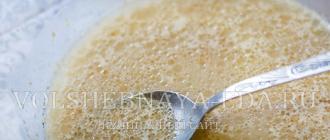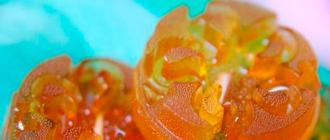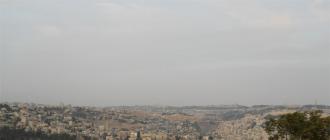Today we are going to the country of Geometry, where we will get acquainted with different types of triangles.
Consider the geometric shapes and find the “extra” one among them (Fig. 1).
Rice. 1. Illustration for example
We see that figures No. 1, 2, 3, 5 are quadrilaterals. Each of them has its own name (Fig. 2).

Rice. 2. Quadrilaterals
This means that the “extra” figure is a triangle (Fig. 3).

Rice. 3. Illustration for example
A triangle is a figure that consists of three points that do not lie on the same line and three segments connecting these points in pairs.
The points are called vertices of the triangle, segments - his parties. The sides of the triangle form There are three angles at the vertices of a triangle.
The main features of a triangle are three sides and three corners. According to the size of the angle, triangles are acute, rectangular and obtuse.
A triangle is called acute-angled if all three of its angles are acute, that is, less than 90° (Fig. 4).

Rice. 4. Acute triangle
A triangle is called rectangular if one of its angles is 90° (Fig. 5).

Rice. 5. Right Triangle
A triangle is called obtuse if one of its angles is obtuse, that is, more than 90° (Fig. 6).

Rice. 6. Obtuse triangle
Based on the number of equal sides, triangles are equilateral, isosceles, scalene.
An isosceles triangle is one in which two sides are equal (Fig. 7).

Rice. 7. Isosceles triangle
These sides are called lateral, third party - basis. IN isosceles triangle the angles at the base are equal.
There are isosceles triangles acute and obtuse(Fig. 8) .

Rice. 8. Acute and obtuse isosceles triangles
An equilateral triangle is one in which all three sides are equal (Fig. 9).

Rice. 9. Equilateral triangle
In an equilateral triangle all angles are equal. Equilateral triangles Always acute-angled.
A scalene triangle is one in which all three sides have different lengths(Fig. 10).
![]()
Rice. 10. Scalene triangle
Complete the task. Distribute these triangles into three groups (Fig. 11).

Rice. 11. Illustration for the task
First, let's distribute according to the size of the angles.
Acute triangles: No. 1, No. 3.
Right triangles: No. 2, No. 6.
Obtuse triangles: No. 4, No. 5.
We will distribute the same triangles into groups according to the number of equal sides.
Scalene triangles: No. 4, No. 6.
Isosceles triangles: No. 2, No. 3, No. 5.
Equilateral triangle: No. 1.
Look at the pictures.
Think about what piece of wire each triangle was made from (Fig. 12).

Rice. 12. Illustration for the task
You can think like this.
The first piece of wire is divided into three equal parts, so you can make an equilateral triangle from it. He is shown third in the picture.
The second piece of wire is divided into three different parts, so it can be used to make a scalene triangle. It is shown first in the picture.
The third piece of wire is divided into three parts, where two parts have the same length, which means that an isosceles triangle can be made from it. In the picture he is shown second.
Today in class we learned about different types of triangles.
References
- M.I. Moreau, M.A. Bantova and others. Mathematics: Textbook. 3rd grade: in 2 parts, part 1. - M.: “Enlightenment”, 2012.
- M.I. Moreau, M.A. Bantova and others. Mathematics: Textbook. 3rd grade: in 2 parts, part 2. - M.: “Enlightenment”, 2012.
- M.I. Moro. Math lessons: Methodical recommendations for the teacher. 3rd grade. - M.: Education, 2012.
- Regulatory document. Monitoring and evaluation of learning outcomes. - M.: “Enlightenment”, 2011.
- "School of Russia": Programs for primary school. - M.: “Enlightenment”, 2011.
- S.I. Volkova. Mathematics: Test work. 3rd grade. - M.: Education, 2012.
- V.N. Rudnitskaya. Tests. - M.: “Exam”, 2012.
- Nsportal.ru ().
- Prosv.ru ().
- Do.gendocs.ru ().
Homework
1. Complete the phrases.
a) A triangle is a figure that consists of ... that do not lie on the same line, and ... that connect these points in pairs.
b) The points are called … , segments - his … . The sides of the triangle form at the vertices of the triangle ….
c) According to the size of the angle, triangles are ... , ... , ... .
d) Based on the number of equal sides, triangles are ... , ... , ... .
2. Draw
A) right triangle;
b) acute triangle;
c) obtuse triangle;
d) equilateral triangle;
e) scalene triangle;
e) isosceles triangle.
3. Create an assignment on the topic of the lesson for your friends.
Triangle is a polygon with three sides (or three angles). The sides of a triangle are often designated by small letters (a, b, c), which correspond to capital letters, indicating opposite vertices (A, B, C).
If all three angles of a triangle are acute, then it is acute triangle.
If one of the angles in a triangle is right, then it is right triangle. The sides forming a right angle are called legs. The side opposite the right angle is called hypotenuse.
If one of the angles in a triangle is obtuse, then it is obtuse triangle.
Isosceles triangle, if its two sides are equal; these equal sides are called lateral, and the third side is called the base of the triangle.
Equilateral triangle, if all its sides are equal.
Basic properties of triangles
In any triangle:
1. It lies opposite the larger side larger angle, and vice versa.
2. Equal angles lie opposite equal sides, and vice versa.
In particular, all angles in an equilateral triangle are equal.
3. The sum of the angles of a triangle is 180º.
From the last two properties it follows that every angle in an equilateral
triangle is 60º.
4. Continuing one of the sides of the triangle, we get the outer
corner. External angle of a triangle equal to the sum internal corners,
not adjacent to it.
5. Any side of a triangle is less than the sum of the other two sides and greater
their differences.
Signs of equality of triangles.
Triangles are congruent if they are respectively equal:
A) two sides and the angle between them;
b) two corners and the side adjacent to them;
c) three sides.
Signs of equality of right triangles.
Two right triangles are congruent if one of the following conditions is true:
1) their legs are equal;
2) the leg and hypotenuse of one triangle are equal to the leg and hypotenuse of the other;
3) the hypotenuse and acute angle of one triangle are equal to the hypotenuse and acute angle of the other;
4) the leg and the adjacent acute angle of one triangle are equal to the leg and the adjacent acute angle of the other;
5) the leg and the opposite acute angle of one triangle are equal to the leg and the opposite acute angle of the other.
Triangle height is a perpendicular dropped from any vertex to the opposite side (or its continuation). This side is called the base of the triangle. The three altitudes of a triangle always intersect at one point called orthocenter of the triangle. The orthocenter of an acute triangle is located inside the triangle, and the orthocenter of an obtuse triangle is outside; The orthocenter of a right triangle coincides with the vertex right angle.
Median is a segment connecting any vertex of a triangle with the middle of the opposite side. Three medians of a triangle intersect at one point, which always lies inside the triangle and is its center of gravity. This point divides each median in a ratio of 2:1, counting from the vertex.
Property of the median of an isosceles triangle. In an isosceles triangle, the median drawn to the base is the bisector and the altitude.
Bisector- this is the bisector segment of the angle from the vertex to the point of intersection with the opposite side. The three bisectors of a triangle intersect at one point, which always lies inside the triangle and is center of the inscribed circle. The bisector divides the opposite side into parts proportional to the adjacent sides.
Median perpendicular is a perpendicular drawn from the midpoint of a segment (side). The three midperpendiculars of a triangle intersect at one point, which is the center of the circumscribed circle. In an acute triangle, this point lies inside the triangle; in an obtuse angle - outside; in a rectangular one - in the middle of the hypotenuse. The orthocenter, center of gravity, circumcenter and inscribed circle coincide only in an equilateral triangle.
Middle line of the triangle is a segment connecting the midpoints of its two sides.
Property of the midline of a triangle. The middle line of the triangle, connecting the midpoints of two given sides, is parallel to the third side and equal to half of it.
Pythagorean theorem. In a right triangle, the square of the length of the hypotenuse is equal to the sum of the squares of the lengths of the legs. c 2 = a 2 + b 2 .
Proofs of the Pythagorean theorem you can see Here.
Theorem of sines. The sides of a triangle are proportional to the sines of the opposite angles .
Cosine theorem. The square of any side of a triangle is equal to the sum of the squares of the other two sides without twice the product of these sides by the cosine of the angle between them .
Proofs of the sine theorem and the cosine theorem you can see Here.
Theorem on the sum of angles in a triangle. The sum of the interior angles of a triangle is 180°.
Triangle Exterior Angle Theorem. An exterior angle of a triangle is equal to the sum of two interior angles that are not adjacent to it.
Dividing triangles into acute, rectangular and obtuse. Classification by aspect ratio divides triangles into scalene, equilateral and isosceles. Moreover, each triangle simultaneously belongs to two. For example, it can be rectangular and scalene at the same time.
When determining the type by the type of angles, be very careful. An obtuse triangle will be called a triangle in which one of the angles is , that is, more than 90 degrees. A right triangle can be calculated by having one right (equal to 90 degrees) angle. However, to classify a triangle as acute, you will need to make sure that all three of its angles are acute.
Defining the species triangle according to the aspect ratio, first you will have to find out the lengths of all three sides. However, if, according to the condition, the lengths of the sides are not given to you, the angles can help you. A scalene triangle is one in which all three sides have different lengths. If the lengths of the sides are unknown, then a triangle can be classified as scalene if all three of its angles are different. A scalene triangle can be obtuse, right, or acute.
An isosceles triangle is one in which two of its three sides are equal to each other. If the lengths of the sides are not given to you, use two equal angles as a guide. An isosceles triangle, like a scalene triangle, can be obtuse, rectangular or acute.
Only a triangle can be equilateral if all three sides have the same length. All its angles are also equal to each other, and each of them is equal to 60 degrees. From this it is clear that equilateral triangles are always acute.
Tip 2: How to determine an obtuse and acute triangle
The simplest of polygons is a triangle. It is formed using three points lying in the same plane, but not on the same straight line, connected in pairs by segments. However, there are triangles different types, which means they have different properties.
Instructions
It is customary to distinguish three types: obtuse-angled, acute-angled and rectangular. It's like corners. An obtuse triangle is a triangle in which one of the angles is obtuse. An obtuse angle is an angle that is greater than ninety degrees but less than one hundred and eighty. For example, in triangle ABC, angle ABC is 65°, angle BCA is 95°, and angle CAB is 20°. Angles ABC and CAB are less than 90°, but angle BCA is greater, which means the triangle is obtuse.
An acute triangle is a triangle in which all angles are acute. An acute angle is an angle that is less than ninety degrees and greater than zero degrees. For example, in triangle ABC, angle ABC is 60°, angle BCA is 70°, and angle CAB is 50°. All three angles are less than 90°, which means it is a triangle. If you know that all sides of a triangle are equal, this means that all its angles are also equal to each other, and they are equal to sixty degrees. Accordingly, all angles in such a triangle are less than ninety degrees, and therefore such a triangle is acute.
If in a triangle one of the angles is equal to ninety degrees, this means that it is neither a wide-angle nor an acute-angle type. This is a right triangle.
If the type of triangle is determined by the ratio of the sides, they will be equilateral, scalene and isosceles. In an equilateral triangle, all sides are equal, and this, as you found out, means that the triangle is acute. If a triangle has only two sides equal or the sides are not equal, it can be obtuse, rectangular, or acute. This means that in these cases it is necessary to calculate or measure the angles and draw conclusions according to points 1, 2 or 3.
Video on the topic
Sources:
- obtuse triangle
The equality of two or more triangles corresponds to the case when all sides and angles of these triangles are equal. However, there are a number of simpler criteria for proving this equality.

You will need
- Geometry textbook, sheet of paper, pencil, protractor, ruler.
Instructions
Open your seventh grade geometry textbook to the section on the criteria for congruence of triangles. You will see that there are a number of basic signs that prove the equality of two triangles. If the two triangles whose equality is being checked are arbitrary, then for them there are three main signs of equality. If any additional information about triangles, then the main three features are supplemented by several more. This applies, for example, to the case of equality of right triangles.
Read the first rule about congruence of triangles. As you know, it allows you to consider triangles equal if it can be proven that any one angle and two adjacent sides of two triangles are equal. In order to understand this law, draw on a piece of paper using a protractor two identical specific angles formed by two rays emanating from one point. Using a ruler, measure the same sides from the top of the drawn angle in both cases. Using a protractor, measure the resulting angles of the two triangles formed, making sure they are equal.
In order not to resort to such practical measures to understand the test for equality of triangles, read the proof of the first test for equality. The fact is that every rule about the equality of triangles has a strict theoretical proof, it’s just not convenient to use for the purpose of memorizing the rules.
Read the second test for congruence of triangles. It states that two triangles will be equal if any one side and two adjacent angles of two such triangles are equal. To remember this rule, imagine the drawn side of a triangle and two adjacent angles. Imagine that the lengths of the sides of the corners gradually increase. Eventually they will intersect, forming a third corner. In this mental task, it is important that the point of intersection of the sides that are mentally increased, as well as the resulting angle, are uniquely determined by the third side and two adjacent angles.
If you are not given any information about the angles of the triangles being studied, then use the third criterion for the equality of triangles. According to this rule, two triangles are considered equal if all three sides of one of them are equal to the corresponding three sides of the other. Thus, this rule says that the lengths of the sides of a triangle uniquely determine all the angles of the triangle, which means they uniquely determine the triangle itself.
Video on the topic
The simplest polygon that is studied in school is a triangle. It is more understandable for students and encounters fewer difficulties. Despite the fact that there are various types triangles that have special properties.
What shape is called a triangle?
Formed by three points and segments. The first ones are called vertices, the second ones are called sides. Moreover, all three segments must be connected so that angles are formed between them. Hence the name of the “triangle” figure.
Differences in names across corners
Since they can be acute, obtuse and straight, the types of triangles are determined by these names. Accordingly, there are three groups of such figures.
- First. If all the angles of a triangle are acute, then it will be called acute. Everything is logical.
- Second. One of the angles is obtuse, which means the triangle is obtuse. It couldn't be simpler.
- Third. There is an angle equal to 90 degrees, which is called a right angle. The triangle becomes rectangular.
Differences in names on the sides
Depending on the characteristics of the sides, the following types of triangles are distinguished:
the general case is scalene, in which all sides are of arbitrary length;
isosceles, two sides of which have the same numerical values;
equilateral, the lengths of all its sides are the same.
If not specified in the task specific type triangle, then you need to draw an arbitrary one. Which has all the corners sharp, and the sides have different lengths.

Properties common to all triangles
- If you add up all the angles of a triangle, you get a number equal to 180º. And it doesn't matter what type it is. This rule always applies.
- The numerical value of any side of a triangle is less than the other two added together. Moreover, it is greater than their difference.
- Every external corner has the value that is obtained by adding two internal ones that are not adjacent to it. Moreover, it is always larger than the internal one adjacent to it.
- The smallest angle is always opposite the smaller side of the triangle. And vice versa, if the side is large, then the angle will be the largest.
These properties are always valid, no matter what types of triangles are considered in the problems. All the rest follow from specific features.
Properties of an isosceles triangle
- The angles that are adjacent to the base are equal.
- The height, which is drawn to the base, is also the median and bisector.
- The altitudes, medians and bisectors, which are built to the lateral sides of the triangle, are respectively equal to each other.

Properties of an equilateral triangle
If there is such a figure, then all the properties described a little above will be true. Because an equilateral will always be isosceles. But not vice versa; an isosceles triangle will not necessarily be equilateral.
- All its angles are equal to each other and have a value of 60º.
- Any median of an equilateral triangle is its altitude and bisector. Moreover, they are all equal to each other. To determine their values, there is a formula that consists of the product of the side and the square root of 3 divided by 2.

Properties of a right triangle
- Two acute angles add up to 90º.
- The length of the hypotenuse is always greater than that of any of the legs.
- The numerical value of the median drawn to the hypotenuse is equal to its half.
- The leg is equal to the same value if it lies opposite an angle of 30º.
- The height, which is drawn from the vertex with a value of 90º, has a certain mathematical dependence on the legs: 1/n 2 = 1/a 2 + 1/b 2. Here: a, b - legs, n - height.

Problems with different types of triangles
No. 1. Given an isosceles triangle. Its perimeter is known and equal to 90 cm. We need to find out its sides. As additional condition: the side side is 1.2 times smaller than the base.
The value of the perimeter directly depends on the quantities that need to be found. The sum of all three sides will give 90 cm. Now you need to remember the sign of a triangle, according to which it is isosceles. That is, the two sides are equal. You can create an equation with two unknowns: 2a + b = 90. Here a is the side, b is the base.
Now it's time for an additional condition. Following it, the second equation is obtained: b = 1.2a. You can substitute this expression into the first one. It turns out: 2a + 1.2a = 90. After transformations: 3.2a = 90. Hence a = 28.125 (cm). Now it is easy to find out the basis. This is best done from the second condition: b = 1.2 * 28.125 = 33.75 (cm).
To check, you can add three values: 28.125 * 2 + 33.75 = 90 (cm). That's right.
Answer: The sides of the triangle are 28.125 cm, 28.125 cm, 33.75 cm.
No. 2. The side of an equilateral triangle is 12 cm. You need to calculate its height.
Solution. To find the answer, it is enough to return to the moment where the properties of the triangle were described. This is the formula for finding the height, median and bisector of an equilateral triangle.
n = a * √3 / 2, where n is the height and a is the side.
Substitution and calculation give the following result: n = 6 √3 (cm).
There is no need to memorize this formula. It is enough to remember that the height divides the triangle into two rectangular ones. Moreover, it turns out to be a leg, and the hypotenuse in it is the side of the original one, the second leg is half known party. Now you need to write down the Pythagorean theorem and derive a formula for height.
Answer: height is 6 √3 cm.
No. 3. Given MKR is a triangle, in which angle K makes 90 degrees. The sides MR and KR are known, they are equal to 30 and 15 cm, respectively. We need to find out the value of angle P.
Solution. If you make a drawing, it becomes clear that MR is the hypotenuse. Moreover, it is twice as large as the side of the KR. Again you need to turn to the properties. One of them has to do with angles. From it it is clear that the KMR angle is 30º. This means that the desired angle P will be equal to 60º. This follows from another property, which states that the sum of two sharp corners should be 90º.
Answer: angle P is 60º.

No. 4. We need to find all the angles of an isosceles triangle. It is known about it that the external angle from the angle at the base is 110º.
Solution. Since only the external angle is given, this is what you need to use. It forms an unfolded angle with the internal one. This means that in total they will give 180º. That is, the angle at the base of the triangle will be equal to 70º. Since it is isosceles, the second angle has the same value. It remains to calculate the third angle. According to a property common to all triangles, the sum of the angles is 180º. This means that the third will be defined as 180º - 70º - 70º = 40º.
Answer: the angles are 70º, 70º, 40º.
No. 5. It is known that in an isosceles triangle the angle opposite the base is 90º. There is a point marked on the base. The segment connecting it to a right angle divides it in the ratio of 1 to 4. You need to find out all the angles of the smaller triangle.
Solution. One of the angles can be determined immediately. Since the triangle is right-angled and isosceles, those that lie at its base will be 45º each, that is, 90º/2.
The second of them will help you find the relation known in the condition. Since it is equal to 1 to 4, the parts into which it is divided are only 5. This means that to find out the smaller angle of a triangle you need 90º/5 = 18º. It remains to find out the third. To do this, you need to subtract 45º and 18º from 180º (the sum of all angles of the triangle). The calculations are simple, and you get: 117º.






